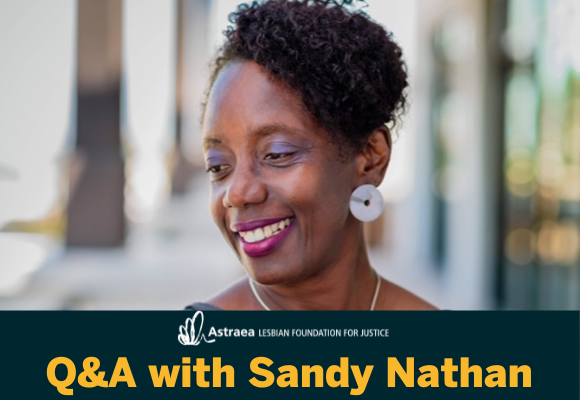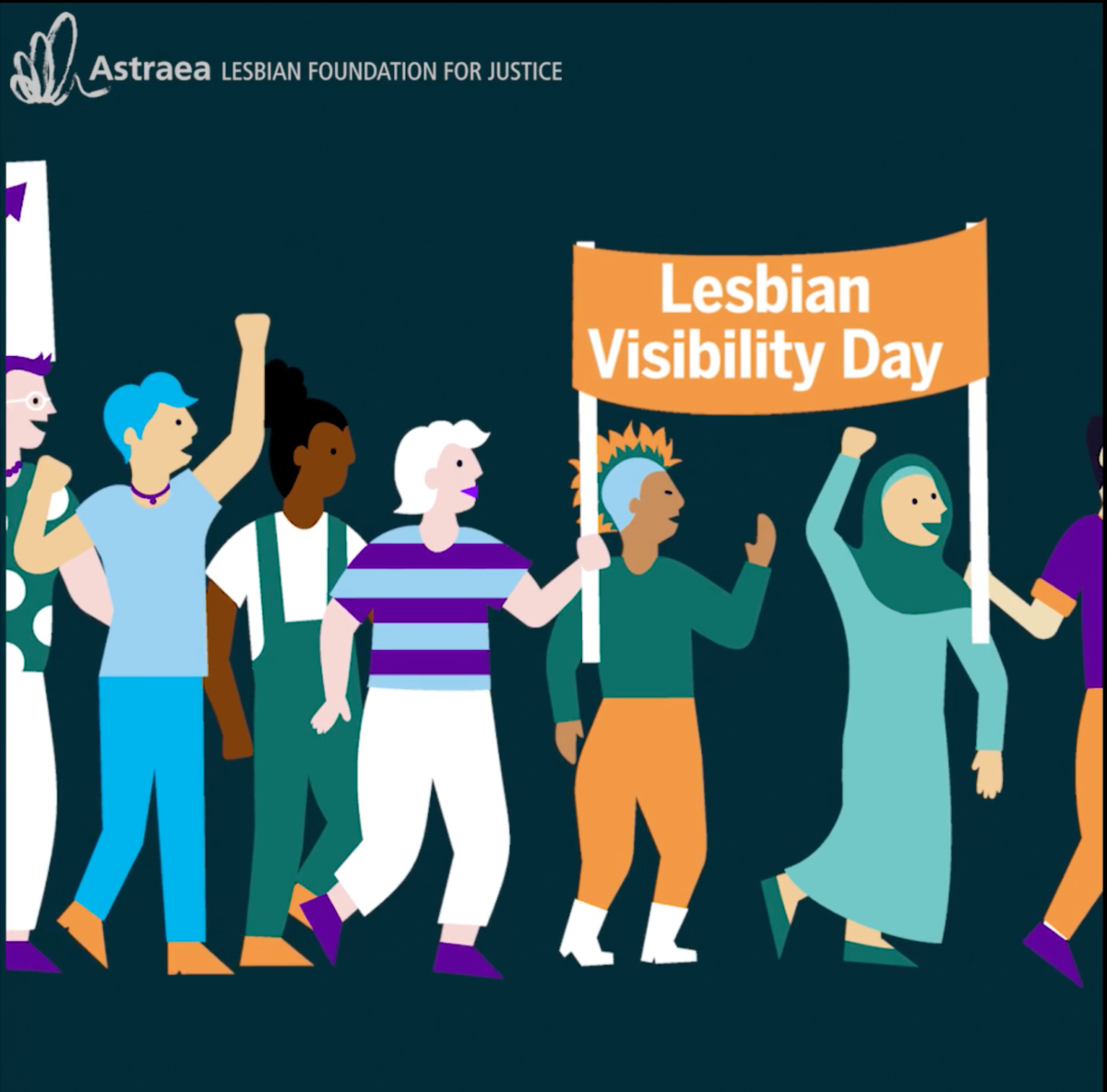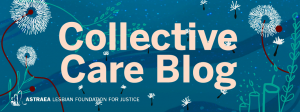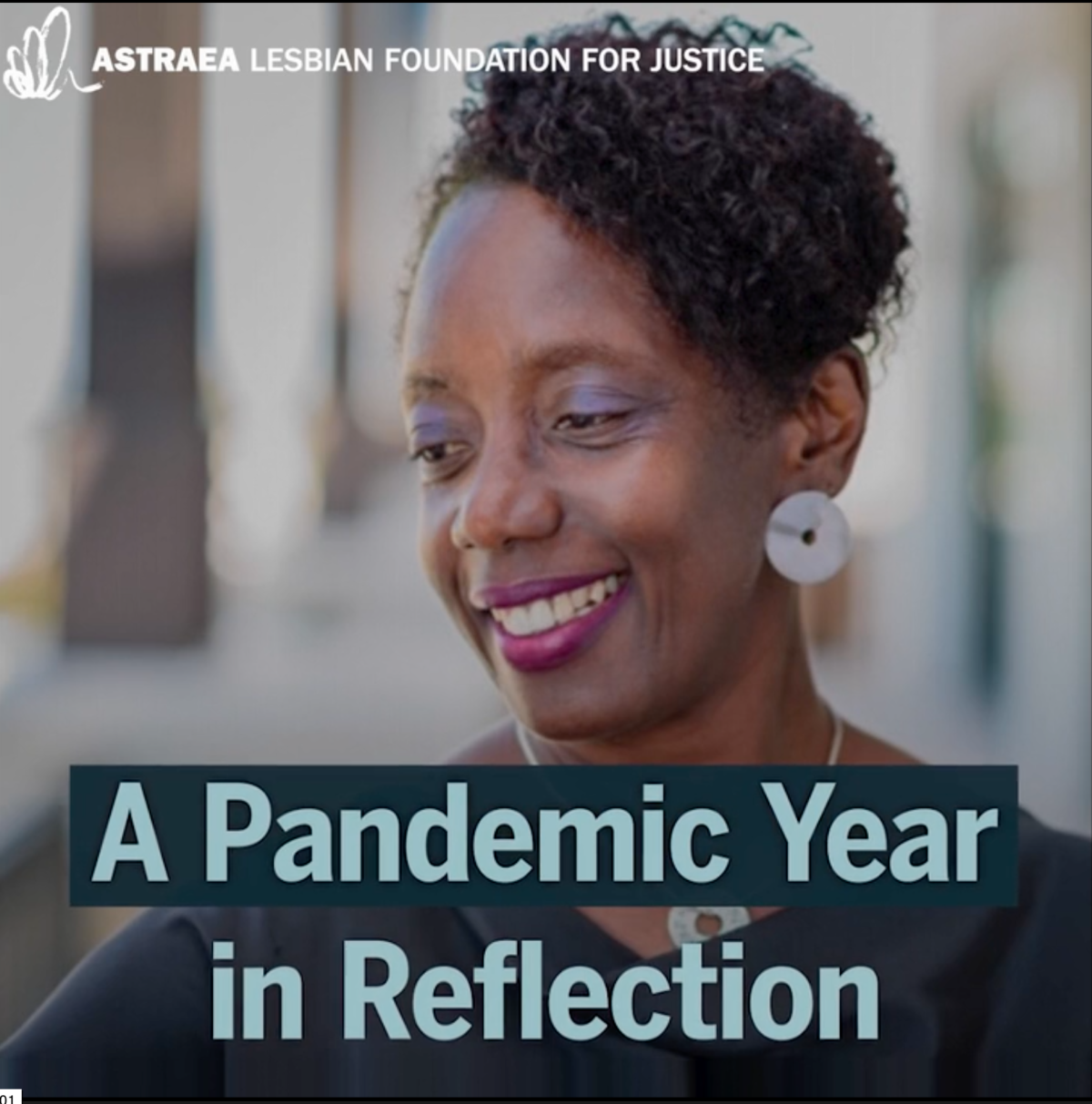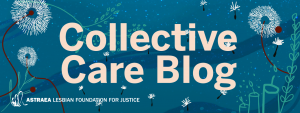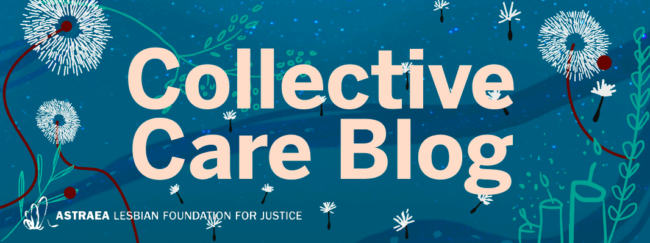- Sandy, you have led Astraea through so much – a global pandemic, racial justice uprisings and internal transitions. What did this mean for you and Astraea and how did you shift your leadership to respond accordingly?
I was hired as Astraea’s Interim Executive Director by the Board of Directors in August 2019 for an initial nine month period. On average, it takes a board that period of time to recruit a new Executive Director. As Astraea’s Interim ED, I saw my role as helping the Board assess the actual state of the organization after the departure of its last ED so that there was a clear and shared vision of what the organization needed in its next permanent leader.
As an Interim ED, my approach was always to assess organizational strengths and challenges, make recommendations to address those challenges, and steady the ship until a new permanent leader was recruited. As a seasoned executive leader with prior positions in government, national nonprofits and philanthropy, I consider myself adept as both an operational and strategic leader. Mind you, all my prior experiences had been in very traditional and patriarchal institutions and organizations. As a Black feminist, I have had very deep and personal experiences socially and politically in feminist settings and in and around social justice movements, but I had never worked directly in an explicitly lesbian feminist organization. So, the very first major shift was realizing that I no longer needed to compartmentalize myself in terms of my race and sexual identity, and for the first time in my professional life, be a truly integrated leader for Astraea. This was by no means an easy transition for me, as the actual state of the culture, systems and ways of being in the organization challenged my conventional sensibilities. But in reflecting on all the core values Astraea espoused – justice, integrity, liberation, intersectional feminism, collective care, and transformation – they deeply aligned with my personal values. This was the primary factor that made all the subsequent shifts even easier.
When the global pandemic hit, it was a major disruption as we were in the midst of engaging in meaningful work to build more alignment between the board and staff, addressing internal issues and building staff morale. What the pandemic accomplished for me and Astraea, however, was understanding how important it was to shift from an organizational change process to one of organizational transformation. The pandemic felt apocalyptic to me, everything that was normal was suddenly gone. Last year truly changed everything, including my prior theories, notions and approaches to leadership, which upon reflection, centered the needs of the organization rather than a focus on listening to staff needs and centering their care and well-being as the highest organizational priority.
In addition to the pandemic, the racial justice uprisings that so dramatically spotlighted all the inequities and deeply rooted systems of oppression and white supremacy, simply made focusing on all the ways that I as a Black, queer, feminist leader needed to step up in that moment even more compelling. And of course, I had to deal with my own pain and anguish even as I constantly thought about all the ways that Astraea’s staff needed to be held through those moments.
- You joined Astraea at a specific moment of leadership transition, can you chat about what transition leadership has allowed you to do that would not have been possible for a permanent leader?
Astraea was my third transitional leadership position. As a transitional leader I make three explicit commitments to the board: 1) that I will always be transparent, 2) that I will speak truth to power and not shrink back from having difficult conversations; and the most important one is 3) that I will not apply for the permanent position. With transitional leadership you have a very finite period of time in which to be impactful and make needed changes, so you must be laser focused on setting priorities, having clear expectations from the board and adhering to those. And if you are not in your integrity and decide you will throw your hat in the ring as the permanent Executive Director, there is a tendency to see yourself as constantly auditioning for the permanent role rather than being the most effective interim leader you can be. As I referenced earlier, I saw it as my role to stabilize the organization, refine fiscal and human resources systems and make key hires to build out the leadership team, and most importantly to identify the critical next steps that a new permanent leader needed to come in and prioritize. All this required taking on a critical view of the organization while at the same time, seeing all of its possibilities.
In many ways Astraea was not prepared for a new permanent leader and bringing in a transitional leader was a great strategic decision by the board. Taking the needed space to listen to staff and build authentic relationships with them and the board, conduct a robust organizational assessment and identify needed changes without the demands of heavy-duty fundraising and being externally focused really enabled me to concentrate on the needs of the organization at that time.
- Your leadership has exemplified what it means to build policies and procedures that center care. When you joined many of us were burned out and collectively feeling exhausted. What are some of the ways you centered care and healing in your transitional leadership and why was that important for the next leader?
One of the real sources of pride for me in leading Astraea was how we were shifting the field of philanthropy by focusing on healing justice. I must recognize Cara Page as another Black queer feminist leader at Astraea who developed this incredible framework that identifies how we can holistically respond to and intervene on generational trauma and violence and bring collective practices to change the consequences of oppression. When I say that Astraea was leading the field – we were doing that with conference presentations, publications and in other tangible ways. What really struck me, however, was how we were not living the values of healing justice internally. The state of mind and bodies for many staff people at Astraea really underscored for me how important it was to center care. I made self- and collective care organizational priorities because of the extent of burn-out and exhaustion at Astraea. The average staff person was managing multiple roles and functions within the organization and it was simply not sustainable as the fall-out from that exhaustion impacted both individuals and the culture. I worked for months with the management team to develop work plans that focused on the most essential priorities. It was a challenging task because as smart and capable as the management team was, they hadn’t been supported in cultivating a practice of priority-setting but rather to take on more and more work.
The pandemic honed our focus on self and collective care as an absolute imperative. When I saw how challenging it was to adhere to policy changes in response to the pandemic such as a 20-hour work week, I instituted an organizational pause for two weeks and encourage staff to take the time to rest, journal and reflect on all the ways in which they needed to show up differently for themselves, their loved ones and the work they were so passionately dedicated to at Astraea. I only wish I could have made the pause for 30 days, because that is widely recognized as the baseline period in which it takes to shift behaviors. But the organizational pause was highly effective in that it was at least a sanctioned period to step away from work, rest and heal. I am extremely grateful to Reverend angel Kyodo Williams who guided us spiritually into that pause and enabled us to reflect collectively after it ended so that we could all understand that self-care was a radical practice we needed to embody moving forward.
As we continue to deal externally with state-sanctioned violence and oppression not just in the U.S. but across the globe, it is critical for Astraea’s next leader to now lead an organization that is finally institutionalizing healing justice practices internally through self and collective care. This will be required if we are to continue to do our work effectively and best serve grassroots LGBTQI movements.
- What have been some of your highlights over the past two years?
The major highlights for me over the past two years have been the depth of relationships I have had a chance to cultivate with Astraea’s staff, board members and our external stakeholders. Astraea’s staff, past and current, are some of the most creative, thoughtful and passionate folks I have ever had the pleasure to work with. The board of directors are all amazingly dedicated to Astraea and bring a true commitment to providing governance and strategic leadership in all the needed ways. I have been excited to see how they have enjoyed board/staff retreats, strategy sessions and joint learning opportunities. They care deeply about the organization and its staff and as is typical in many organizations, that alignment is not always apparent. And our institutional partners and donors have been wonderful to get to know. Their support to Astraea has enabled the organization to weather this transition as well as it can.
- You have spoken about how Astraea has been a political “home” for you that is able to hold your identities as a black lesbian unicorn in philanthropy – can you tell us more about this and how this is part of Astraea’s vision to shift the nature of philanthropy?
I was in a conversation recently with someone from Emerging Practitioners in Philanthropy and we were discussing the numerous challenges that BIPOC and LGBTQI individuals encounter working in the field. We do have to often shield our multiple identities and with every foundation and its culture, it is a calculation about what part of yourself you must leave at the door. As a very young feminist in the 80’s, I had heard about Astraea as this unique lesbian feminist foundation founded for and by a group of multiracial, cross-class women who came together to raise resources to fund their community. From its inception, Astraea was redefining philanthropy and “democratizing” it before we were using those words. You did not have to be a millionaire to give to Astraea, and it attracted other lesbians from all economic levels because it was in response to the lack of recognition there was at that time of our issues. Astraea was always about reimagining philanthropy and shifting power. So, for me to step into this role as a black feminist queer leader and be that touch stone and link back to our founding mothers has been truly transformational for me.
I also want to add that seeing the pain and suffering of BIPOC and LGBTQ communities as a result of the pandemic and the racial uprisings last year had a deep personal impact on me. As difficult as that time was, I cannot imagine what it would have meant to be anyplace other than Astraea, where my feelings and concerns were supported and uplifted.
- What legacy are you leaving for the next leader of Astraea?
The first legacy that I hope to leave for Astraea’s next leader is to lead this organization with love, compassion and understanding that Astraea cannot be what the world needs it to be without continuing to center its staff at the heart of every key decision. She will have to be a people-centered and trusted leader because I feel that is what staff have become accustomed to. We are as strong as we are today because we have had to practice resilience. We have had to dig deep to bounce back from the obstacles of the past and we are recovering in the face of continued external challenges. At Astraea, we have come to know the difference between urgency and importance, and we have finally come to understand that there are no adverse consequences if we take some risks for us to create a solid and sustainable future. Most importantly to me as a transitional leader, is knowing with absolute confidence that we collectively have created a stronger Astraea than we were two years ago, thus we are now better able to serve our movements.
- Do you have closing words for Astraea and the new leadership?
My closing words for Astraea are that I never imagined it possible to fall in love with an organization and its people, but that has been my experience. There has been something so unique to me about leading Astraea at this time that simply required giving of myself as a leader in ways I never had to step into. And each time I realized that we were creating momentum and shifting things internally, it was because we had developed relationships of trust and open communication. It was not always an easy journey and there were certainly disappointments along the way, however Astraea is an amazing organization and I know that the best is yet to come. I know without a doubt that I will continue to stay connected to Astraea and all the people within its ecosystem that I have come to care about deeply.
***
Read more blog posts on our Collective Care Blog!

